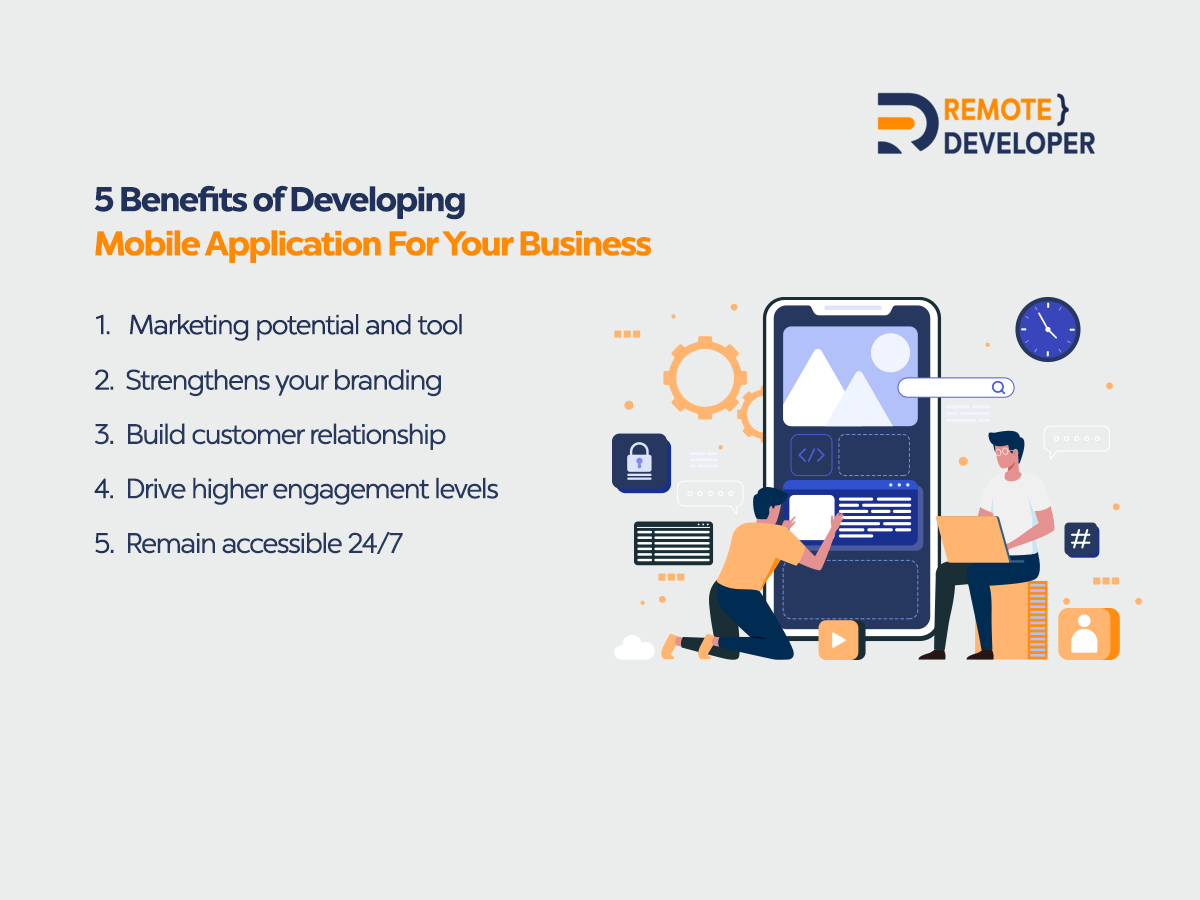Mobile devices have become essential to every individual, household, and business. Even the most traditional and oldest brands, such as Mcdonald’s and Coca-Cola, have used the mobile platform to reach and engage their customers.
That is why for many years, mobile application development has been an in-demand service by many companies. For any business, there is an app for it, might it be for personal needs or enterprise operations. It has become competitive and is now one of the top paying remote jobs.
But why is this the case? So whether you are a business contemplating developing a mobile application or a developer trying to understand mobile app development, this guide is for you! Through this article, you will understand what a mobile application is and why you should develop one for your business. We will also discuss the key six steps in developing a mobile app.
What is a Mobile Application?
Mobile applications are computer programs run on mobile devices such as smartphones or tablets. They provide users with an interface to access the features and services of the device. Likewise, they offer a set of functions that can vary from delivering information like weather updates, news, and stocks. Most mobile applications also let you play games, edit photos and videos, or shop.
Usually, developers make mobile applications using different programming languages. They can run on the mobile device’s operating systems (e.g., Android, iOS). It typically includes a user interface that interacts with the device’s hardware, such as a touchscreen. As such, users can download a mobile application through Google Play, Apple App Store, or your website.
Why Should You Develop a Mobile App For Your Business?
The mobile app market is growing at an astounding rate. In 2021, there were 111 Billion downloads alone in Google Play. That number is expected to grow by 2020. It means more opportunities for businesses to develop their mobile apps and reach new customers globally.
With a mobile app, you can offer your customers the convenience of using your business service in the following ways:

1. Marketing potential and tool
Mobile apps are not just for entertainment anymore. They have become a key component of marketing strategy for many companies worldwide. Mobile applications are the new marketing tool. They allow companies to reach their audience personally and help them grow their business.
This means you can use them as electronic billboards to advertise your company and its products or services or as a platform to personally engage with your customers. You can provide them with information about your company’s latest news and upcoming events through a mobile application.
It also allows you to offer exclusive offers, discounts, promotions, coupons, and rewards only available through your mobile app that can be redeemed at physical stores or online shopping
2. Strengthens your branding
Mobile apps are a great way to increase brand recognition and strengthen your branding. Most customers use their mobile phones daily. Thus, they have more chances to use your application and be aware of your company.
It also allows users to access the information they need at any time and place. And suppose the customers find your practical mobile application. In that case, they are more likely to spread your brand to their colleagues or friends as an efficient and great company.
3. Build customer relationship
Mobile applications are a great way to reach customers and help businesses build better customer relationships. Companies can use mobile applications to promote their products and services, update customers on the latest news, or even give exclusive deals to those who download the app.
4. Drive higher engagement levels
Mobile applications have evolved from simple apps to complex programs that provide a variety of features to customers. They have become necessary for businesses that want to keep their customer engagement rates high.
Mobile applications are the most popular way to engage with customers. If the mobile application is not up to date, it will lose customer engagement and eventually lose customers.
5. Remain accessible 24/7
Many mobile apps are available for companies to use. These mobile apps allow companies to create and maintain a strong customer relationships with their customers. Companies can use these apps to have 24/7 customer service and provide information about their products or services anytime.
How to Build a Mobile Application: 6 Steps Detailed Guide
With so many apps available, it can be difficult for a new app to stand out from the crowd. This section will discuss how to develop your mobile application idea that will be able to help you create your vision for your mobile application.
1. Developing Your Idea
The first step when developing your idea is to clearly understand what you want the app to do. This may seem easy, but it can be difficult if you don’t know what features you want or need in the app already. It’s essential to spend time thinking about what features are most important for your app because this will help narrow down which development
2. Wireframing
Wireframing is designing the layout of a website, application, or other product by creating a diagram showing how all its elements are related to each other. A wireframe is often made to communicate the design and functionality of a website, application, or product to stakeholders. The first step in wireframing is to identify what your goals are for the project. This will help you determine the needed features and which elements can be left out. Then, you need to decide on the content on each page. This includes text and images.
Wireframes should be simple enough so that they can easily be changed if necessary. It should not contain any unnecessary details at this stage because it may confuse stakeholders reviewing them.
3. Mockup
Mockups represent the design and layout of a webpage, application, or any other kind of digital product. Likewise, it is created to help designers, clients, and developers understand what the final product will look like. Mockups can be used for a variety of purposes:
- Understand how the final product will look like
- Communicate ideas to clients and stakeholders
- Create more detailed wireframes that can be used as a blueprint for development work
- Present a design to clients who may not have any technical knowledge about it.
Likewise, mockups can demonstrate how a mobile app will look and function with a user in mind. There are many use cases for mobile application mockups, like presenting an idea to a client, testing an idea, and more.
Thus, your mockups can be created by designers in Photoshop, Sketch, or Illustrator. But the most common way is to use design tools like UXPin that allow you to create high-fidelity prototypes of your product without writing any code.
4. Developing
After coming app with the wireframe and design of the app, it’s time for your developers to make it. The development stage is where all the code and programming are programmed into the app to make it run on a mobile device. Likewise, the process of mobile app development should be divided into three parts:
- Front End App Development – Designing an interactive UI for the end users
- Back End App Development – Includes database and server-side of the mobile app’s functionality
- API Integration – Development of Custom API and integration process requests to ensure that the app functions correctly for a specific OS or device.
5. Testing
Finally, the testing stage is where all of the aspects of an application are tested to ensure they work as intended before being released onto an app store. Testing mobile applications are crucial because it helps identify the app’s bugs, saving developers time and effort. It also helps to increase the app’s quality by removing any errors or defects in the product.
Different types of testing can be done on mobile applications. These include functional testing, usability testing, security testing, localization testing, performance testing, and compatibility testing.
6. Launching of the Mobile App
When everything is done, it’s time to launch your app. Usually, companies try to register their application on the Apple App Store or Google Play. However, these platforms have strong policies to make the app available in their store.
Usually, you need to meet the latest target API level of Google or Apple. You must also ensure that your application is designed for the newest device. Don’t worry, however; you can also upload your app bundle on your website, and customers can download it accordingly.
Ready to Build the Mobile App of Your Dreams?
And that’s it! We hope that by reading this article, you understand the purpose and process of developing mobile applications. Remember that your mobile application’s success heavily depends on your planning, research, and development. These steps are crucial to the usability of your application after launch.
You must get someone professional to develop your application if you are not an expert. And we can help you! Remote Developers have various mobile app developers! Contact us now!

